Abstract
Erythromycin and some other macrolide antibiotics can first induce a cytochrome P-450 isozyme similar to the one induced in rats by pregnenolone-16 alpha-carbonitrile and then inhibit it by forming a stable cytochrome P-450-metabolite complex. The purpose of this study was to compare azithromycin, a novel 15-membered ring azalide, and erythromycin estolate for the potential to cause hepatic microsomal enzyme induction and inhibition in Sprague-Dawley rats. The daily oral administration of 800 mg of erythromycin estolate per kg for 7 days resulted in statistically significant elevations of NADPH-cytochrome c reductase, erythromycin N-demethylase (3.2-fold), and total cytochrome P-450 content. Approximately 40% of cytochrome P-450 was complexed with erythromycin metabolite. In contrast, the daily administration of 200 mg of azithromycin per kg for 7 days caused significant elevations of N-demethylase (2.5-fold) only and did not produce any increases in total cytochrome P-450 content or NADPH-cytochrome c reductase. No complexed cytochrome P-450 was detected in the azithromycin-dosed rats despite liver concentrations of azithromycin that were 118 times greater than the liver concentrations of erythromycin estolate in erythromycin estolate-dosed rats. Although the short-term oral administration of azithromycin produced hepatic accumulation of the drug and elevated azithromycin demethylase activity, there was no other evidence of hepatic cytochrome P-450 induction or inactivation via cytochrome-metabolite complex formation. In contrast to erythromycin estolate, azithromycin is not expected to inhibit its own metabolism or that of other drugs via this pathway.
Full text
PDF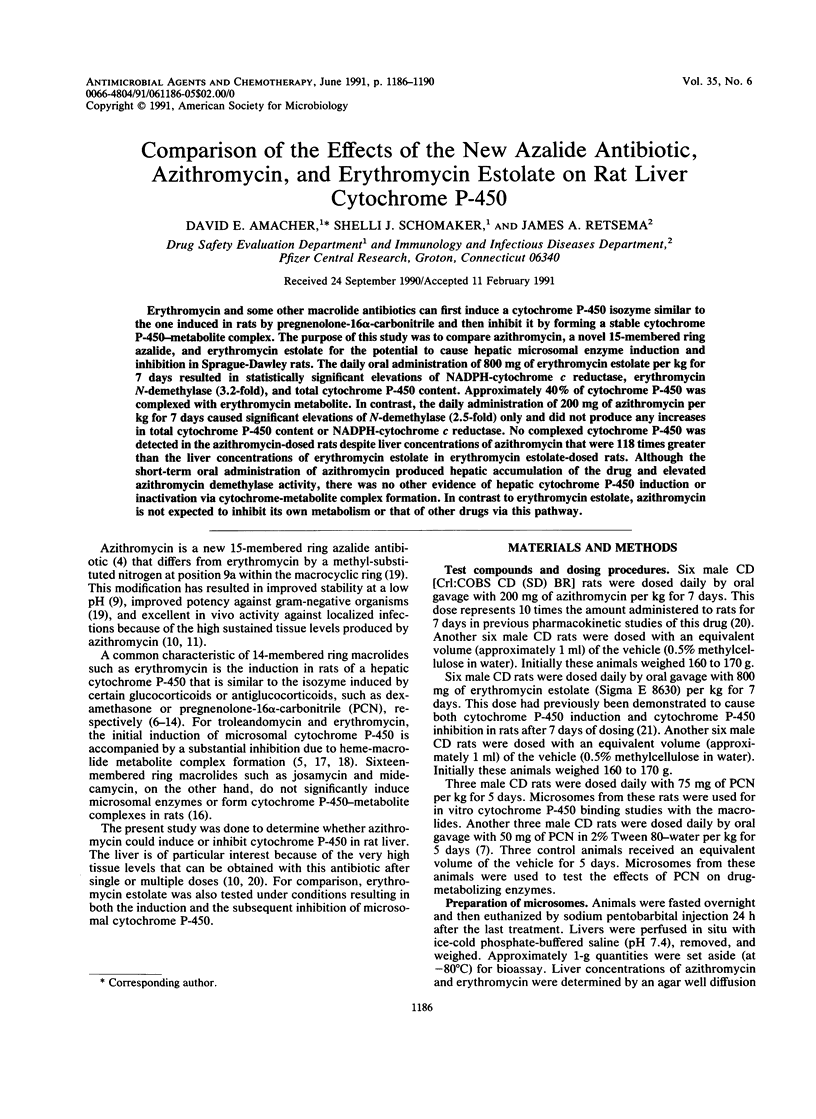
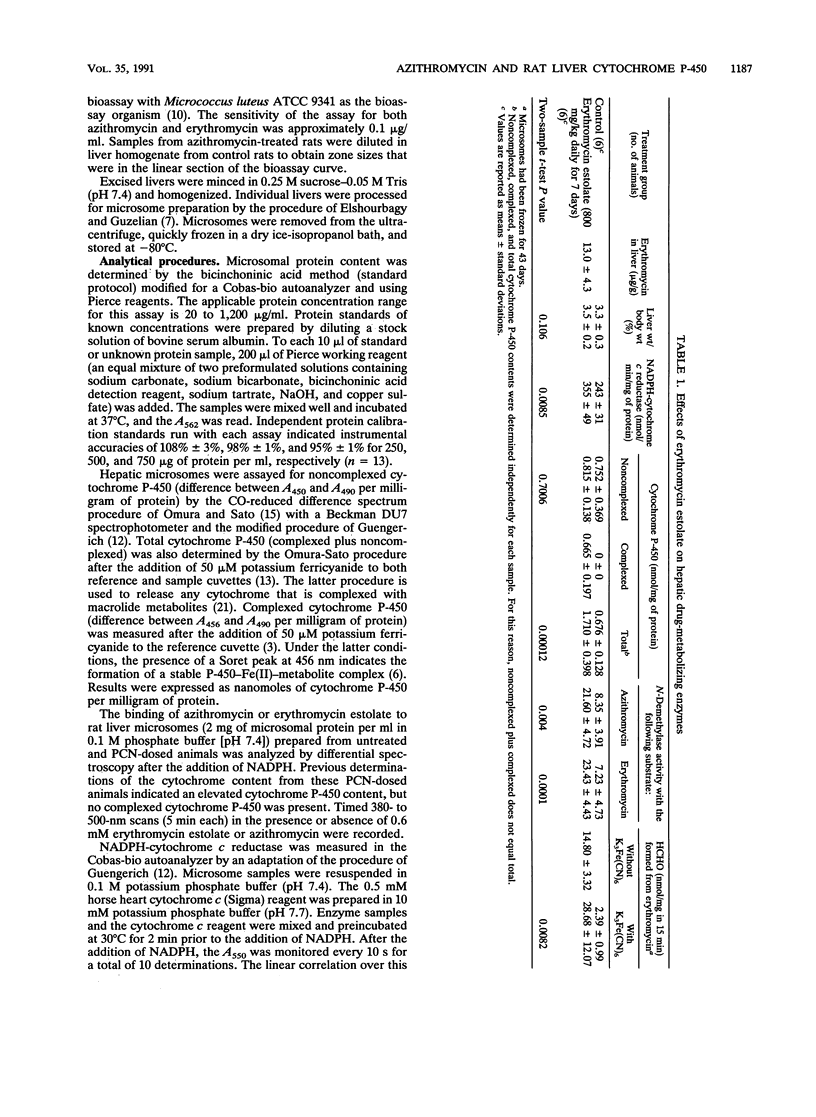
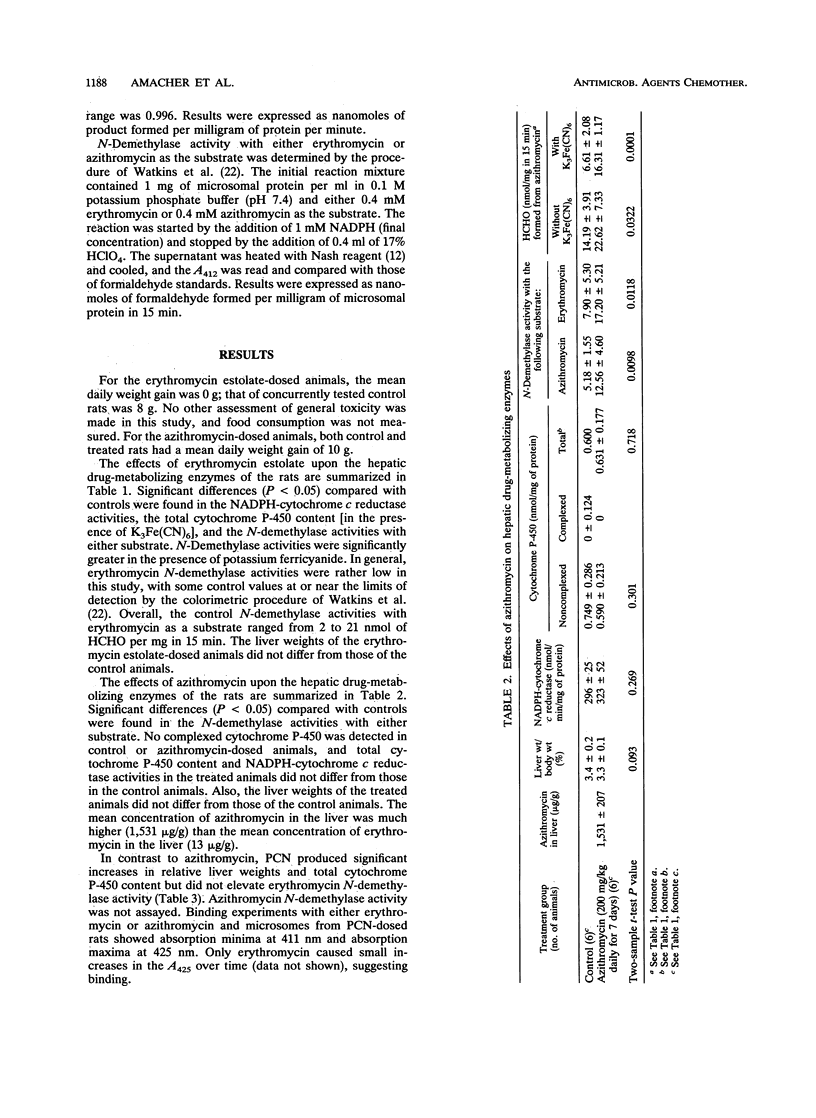
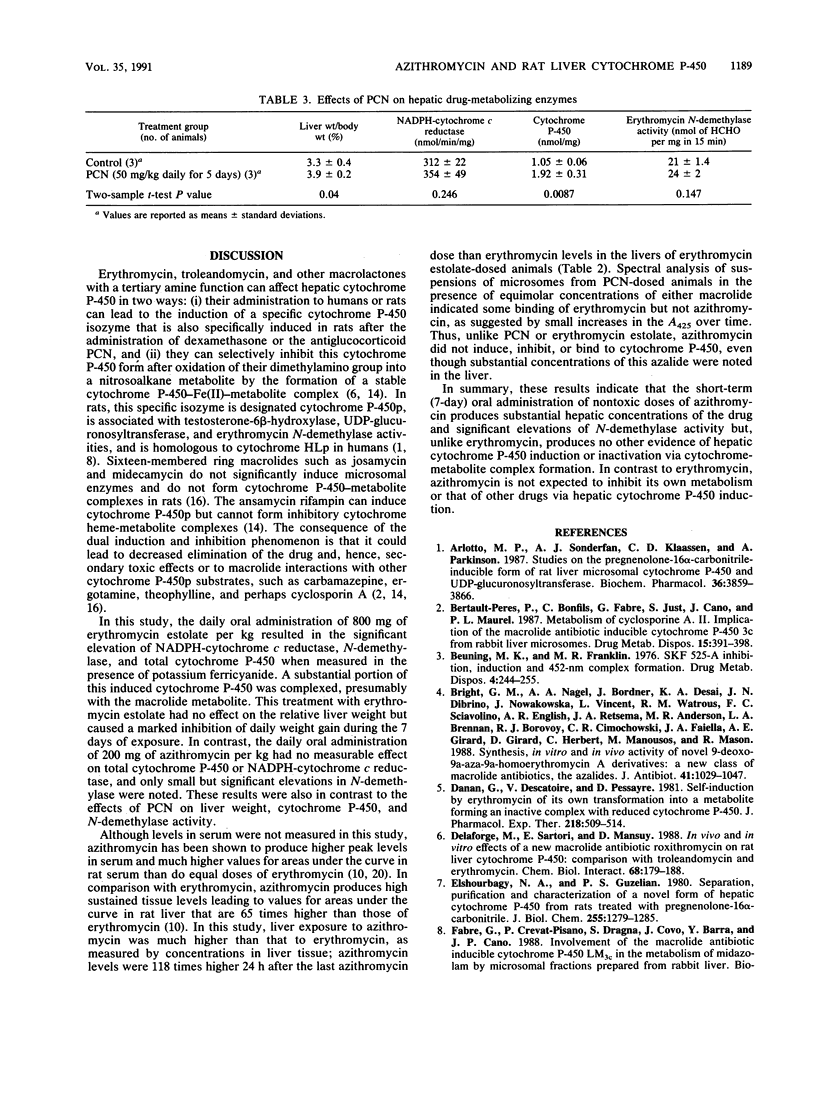
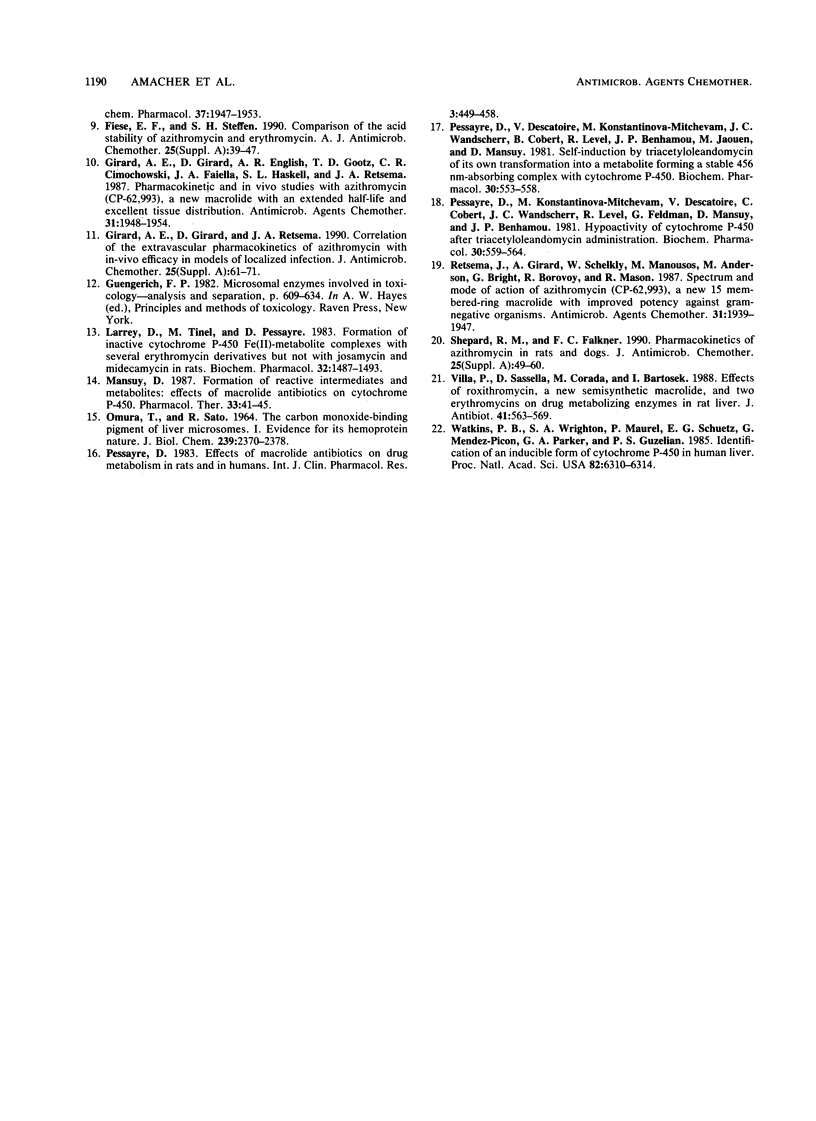
Selected References
These references are in PubMed. This may not be the complete list of references from this article.
- Arlotto M. P., Sonderfan A. J., Klaassen C. D., Parkinson A. Studies on the pregnenolone-16 alpha-carbonitrile-inducible form of rat liver microsomal cytochrome P-450 and UDP-glucuronosyltransferase. Biochem Pharmacol. 1987 Nov 15;36(22):3859–3866. doi: 10.1016/0006-2952(87)90450-3. [DOI] [PubMed] [Google Scholar]
- Bertault-Peres P., Bonfils C., Fabre G., Just S., Cano J. P., Maurel P. Metabolism of cyclosporin A. II. Implication of the macrolide antibiotic inducible cytochrome P-450 3c from rabbit liver microsomes. Drug Metab Dispos. 1987 May-Jun;15(3):391–398. [PubMed] [Google Scholar]
- Bright G. M., Nagel A. A., Bordner J., Desai K. A., Dibrino J. N., Nowakowska J., Vincent L., Watrous R. M., Sciavolino F. C., English A. R. Synthesis, in vitro and in vivo activity of novel 9-deoxo-9a-AZA-9a-homoerythromycin A derivatives; a new class of macrolide antibiotics, the azalides. J Antibiot (Tokyo) 1988 Aug;41(8):1029–1047. doi: 10.7164/antibiotics.41.1029. [DOI] [PubMed] [Google Scholar]
- Buening M. K., Franklin M. R. SKF 525-A inhibition, induction, and 452-nm complex formation. Drug Metab Dispos. 1976 May-Jun;4(3):244–255. [PubMed] [Google Scholar]
- Danan G., Descatoire V., Pessayre D. Self-induction by erythromycin of its own transformation into a metabolite forming an inactive complex with reduced cytochrome P-450. J Pharmacol Exp Ther. 1981 Aug;218(2):509–514. [PubMed] [Google Scholar]
- Delaforge M., Sartori E., Mansuy D. In vivo and in vitro effects of a new macrolide antibiotic roxithromycin on rat liver cytochrome P-450: comparison with troleandomycin and erythromycin. Chem Biol Interact. 1988;68(3-4):179–188. doi: 10.1016/0009-2797(88)90015-4. [DOI] [PubMed] [Google Scholar]
- Elshourbagy N. A., Guzelian P. S. Separation, purification, and characterization of a novel form of hepatic cytochrome P-450 from rats treated with pregnenolone-16 alpha-carbonitrile. J Biol Chem. 1980 Feb 25;255(4):1279–1285. [PubMed] [Google Scholar]
- Fiese E. F., Steffen S. H. Comparison of the acid stability of azithromycin and erythromycin A. J Antimicrob Chemother. 1990 Jan;25 (Suppl A):39–47. doi: 10.1093/jac/25.suppl_a.39. [DOI] [PubMed] [Google Scholar]
- Girard A. E., Girard D., English A. R., Gootz T. D., Cimochowski C. R., Faiella J. A., Haskell S. L., Retsema J. A. Pharmacokinetic and in vivo studies with azithromycin (CP-62,993), a new macrolide with an extended half-life and excellent tissue distribution. Antimicrob Agents Chemother. 1987 Dec;31(12):1948–1954. doi: 10.1128/aac.31.12.1948. [DOI] [PMC free article] [PubMed] [Google Scholar]
- Girard A. E., Girard D., Retsema J. A. Correlation of the extravascular pharmacokinetics of azithromycin with in-vivo efficacy in models of localized infection. J Antimicrob Chemother. 1990 Jan;25 (Suppl A):61–71. doi: 10.1093/jac/25.suppl_a.61. [DOI] [PubMed] [Google Scholar]
- Larrey D., Tinel M., Pessayre D. Formation of inactive cytochrome P-450 Fe(II)-metabolite complexes with several erythromycin derivatives but not with josamycin and midecamycin in rats. Biochem Pharmacol. 1983 May 1;32(9):1487–1493. doi: 10.1016/0006-2952(83)90470-7. [DOI] [PubMed] [Google Scholar]
- Mansuy D. Formation of reactive intermediates and metabolites: effects of macrolide antibiotics on cytochrome P-450. Pharmacol Ther. 1987;33(1):41–45. doi: 10.1016/0163-7258(87)90026-x. [DOI] [PubMed] [Google Scholar]
- OMURA T., SATO R. THE CARBON MONOXIDE-BINDING PIGMENT OF LIVER MICROSOMES. I. EVIDENCE FOR ITS HEMOPROTEIN NATURE. J Biol Chem. 1964 Jul;239:2370–2378. [PubMed] [Google Scholar]
- Pessayre D., Descatoire V., Konstantinova-Mitcheva M., Wandscheer J. C., Cobert B., Level R., Benhamou P. J., Jaouen M., Mansuy D. Self-induction by triacetyloleandomycin of its own transformation into a metabolite forming a stable 456 nm-absorbing complex with cytochrome P-450. Biochem Pharmacol. 1981 Mar 15;30(6):553–558. doi: 10.1016/0006-2952(81)90125-8. [DOI] [PubMed] [Google Scholar]
- Pessayre D. Effects of macrolide antibiotics on drug metabolism in rats and in humans. Int J Clin Pharmacol Res. 1983;3(6):449–458. [PubMed] [Google Scholar]
- Pessayre D., Konstantinova-Mitcheva M., Descatoire V., Cobert B., Wandscheer J. C., Level R., Feldmann G., Mansuy D., Benhamou J. P. Hypoactivity of cytochrome P-450 after triacetyloleandomycin administration. Biochem Pharmacol. 1981 Mar 15;30(6):559–564. doi: 10.1016/0006-2952(81)90126-x. [DOI] [PubMed] [Google Scholar]
- Retsema J., Girard A., Schelkly W., Manousos M., Anderson M., Bright G., Borovoy R., Brennan L., Mason R. Spectrum and mode of action of azithromycin (CP-62,993), a new 15-membered-ring macrolide with improved potency against gram-negative organisms. Antimicrob Agents Chemother. 1987 Dec;31(12):1939–1947. doi: 10.1128/aac.31.12.1939. [DOI] [PMC free article] [PubMed] [Google Scholar]
- Shepard R. M., Falkner F. C. Pharmacokinetics of azithromycin in rats and dogs. J Antimicrob Chemother. 1990 Jan;25 (Suppl A):49–60. doi: 10.1093/jac/25.suppl_a.49. [DOI] [PubMed] [Google Scholar]
- Villa P., Sassella D., Corada M., Bartosek I. Effects of roxithromycin, a new semisynthetic macrolide, and two erythromycins on drug metabolizing enzymes in rat liver. J Antibiot (Tokyo) 1988 Apr;41(4):563–569. doi: 10.7164/antibiotics.41.563. [DOI] [PubMed] [Google Scholar]
- Watkins P. B., Wrighton S. A., Maurel P., Schuetz E. G., Mendez-Picon G., Parker G. A., Guzelian P. S. Identification of an inducible form of cytochrome P-450 in human liver. Proc Natl Acad Sci U S A. 1985 Sep;82(18):6310–6314. doi: 10.1073/pnas.82.18.6310. [DOI] [PMC free article] [PubMed] [Google Scholar]


